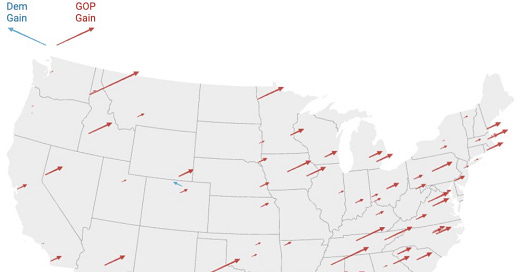Democrats can’t depend on young voters anymore
Our precinct-level analysis broadly aligns with David Shor’s numbers on Gen Z
There's been significant buzz lately about youth voting patterns in the 2024 election and how young voters align themselves politically going forward. Our Spring 2025 Yale poll results helped spark this conversation, showing some interesting trends: 18-29 year olds were essentially tied on the 2026 generic ballot test, but with notable internal differences. The youngest voters (18-21) leaned Republican by 12 points, while those slightly older (22-29) favored Democrats by 6 points.
What surveys say about the youth vote
While this 18-point gap is likely more extreme than reality (surveys and precinct results from 2024 generally indicate a gap smaller than this), our poll highlights two key findings that align with broader data. First, Gen Z is now a battleground demographic, significantly less liberal than Millennials. Second, there is a notable divide within Gen Z itself, with younger members being more pro-Trump and holding more conservative positions on the issues.
These findings line up with what data scientist David Shor of Blue Rose Research said in a recent conversation on Ezra Klein’s podcast. According to Shor, Trump secured plurality support from most young voters in demographic groups in 2024, including under-30 white men and under-30 white women. Perhaps most surprisingly, according to Shor, among 18-year-olds, Harris only maintained majority support among women of color, with Trump narrowly winning young men of color. This represents a remarkable shift that challenges long-held assumptions about Democrats' dominance with youth voters, particularly young nonwhite voters.
Caroline Soler, Brian Schaffner, and Stephen Ansolabehere present a good argument to exercise some caution in a piece on the Tufts Public Opinion Lab Medium account. They emphasize that other major surveys—including exit polls from the AP and NEP, as well as the Cooperative Election Study (CCES)—don't align with Shor's findings. This reminds us of an important principle in data analysis: when multiple independent sources of evidence point in the same direction, our confidence in the conclusion should naturally increase; when sources disagree, our confidence should decrease. They also highlight a crucial methodological challenge: young voters are notoriously difficult to poll accurately, which could explain some of these discrepancies.
Precinct-level results show that college students shifted right from 2020 to 2024
Beyond survey data, we can gain insights by examining publicly available aggregated vote data alongside census information to understand how different groups actually voted. This approach, often called ecological inference, has proven highly effective for analyzing racial voting patterns and is used by organizations like Catalist to produce accurate estimates of vote choice for different racial groups.
While applying this method to age-based voting is somewhat more challenging (since age distribution is less geographically concentrated than racial distribution), we do have one clear idea about how to draw conclusions from this aggregate data: young voters cluster around college campuses. Analyzing election results from college campuses provides a valuable window into how young voters shifted between 2020 and 2024. However, it's worth noting this represents a somewhat unrepresentative sample, skewing whiter and more educated than the broader population of young voters. Because white and college-educated voters tended to shift less towards Republicans in 2026, this suggests the overall shift among young voters was probably more rightward than what campus data alone indicates.
Our analysis of 88 college campuses, which collectively include over a million 18-24 year olds according to census data, revealed a striking trend: 18-24 year olds on college campuses shifted approximately 11 points rightward toward Trump between 2020 and 2024. What makes this particularly noteworthy is that older demographically similar voters—those of the same race, gender, and education level but in older age brackets—showed virtually no shift over the same period. Moreover, evidence suggests that young voters of color moved even more dramatically toward Trump than their white counterparts.
These findings largely align with Shor's analysis. While experts may debate the precise magnitude of the shift, our election results data support his central claim: there was a substantial movement among 18-29-year-old voters toward Trump between 2020 and 2024, transforming what was once a reliable Democratic bloc into a genuine battleground demographic.
The bottom line
Putting it all together, if you assume parallel trends across racial and educational subgroups—that is, that low-education white and nonwhite 18–21 year olds swung similarly to the high-education, predominantly white 18–21 year olds we observe in campus data—you’d likely end up with about a Harris+2 overall margin among 18–21 year olds. And, the intuition here is that young voters of color may have shifted even more to the right than highly educated white youth. That’s a pretty striking departure from the conventional wisdom of youth liberalism, and it broadly aligns with Shor’s estimates.







How many people wanted to (metaphorically) kill the messenger (David Shor)? May we have a show of hands?